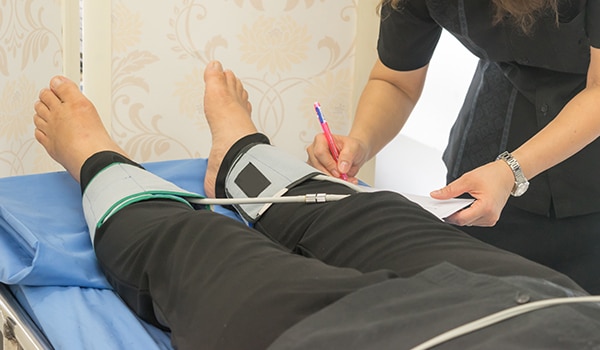Diabetes, Peripheral Arterial Disease, and Foot Ulcers

Learn about diabetic foot ulcers, a common and costly complication of diabetes that often leads to lower limb amputation, and the role peripheral arterial disease (PAD) plays in its development and severity.
Dr. Edward Boyko and Dr. Matilde Monteiro-Soares are co-authors of the chapter, “Peripheral Arterial Disease, Foot Ulcers, Lower Extremity Amputations, and Diabetes,” in the NIDDK publication Diabetes in America, 3rd Edition. Here, they discuss how health care professionals can diagnose PAD and prevent foot complications in patients with diabetes.
Q: What are diabetic foot ulcers? How are diabetes, PAD, and foot ulcers related?
Dr. Monteiro-Soares: There’s still some debate about a specific definition for diabetic foot ulcers. However, experts agree that a diabetic foot ulcer is a break in the skin that must involve at least the epidermis and a part of the dermis, but it can reach more deeply to tendons or even bone. A diabetic foot ulcer may occur anywhere on the foot, but it must be located below the ankle. An ulcer on the ankle would not be classified as a diabetic foot ulcer. Also, the foot ulcer must occur in a person who has a diagnosis of diabetes, of course.
Dr. Boyko: As to the relationship between diabetes, PAD, and foot ulcers, diabetes is characterized by higher-than-normal blood glucose levels that can damage nerves, resulting in a loss of pain sensation in the foot. Also, damage can occur to the motor nerves that control foot muscles, which may lead to foot deformity and high-pressure points. People with diabetes and foot deformity may have high-pressure points leading to sores on the foot that go unnoticed due to the loss of pain sensation.
Diabetes also causes atherosclerosis—narrowing of blood vessels that reduces circulation. People with PAD have reduced blood flow to the feet, which can impair oxygen and nutrient delivery and impede wound healing. An open foot wound creates an entrance point for infection. PAD reduces the flow of blood and immune cells to the feet to fight infections. Infection is a major ulcer complication that often leads to amputation.
Q: How common are PAD and foot ulcers among people who have diabetes?
Dr. Monteiro-Soares: While we don’t have exact numbers, and estimates vary in the literature, we know that many patients suffer from these complications. Recent research suggests that PAD affects up to 25% or 30% of people with diabetes. In earlier studies, ulcers were more common in people who had neuropathy but did not have ischemia—a lack of blood flow to the foot. However, both in our clinics and in available data, we’re seeing an increasing number of patients who have both foot ulcers and ischemia.
For people who have diabetes, the lifetime risk of having a foot ulcer has been estimated at about 20% to 25%. However, updated research suggests that, as people with diabetes are living longer, the lifetime risk of diabetic foot ulcer may be as high as 34%.
Q: For health care professionals caring for patients who have diabetes, what are the challenges involved in diagnosing and managing PAD?
Dr. Boyko: Most patients with PAD are asymptomatic, and PAD can be difficult to diagnose in patients with diabetes. Health care professionals can diagnose PAD by measuring blood pressure in the foot and calculating the ankle-brachial index (ABI). The blood pressure in the foot tends to be higher than in the arm; when blood pressure in the foot is much lower than in the arm, it suggests diminished circulation to the foot. However, diabetes may cause the arteries to become stiff and incompressible, which may falsely elevate foot blood pressure. If the pressure in the foot is falsely high, the ABI may not show that the patient has PAD.
Another challenge for diagnosing and managing PAD is access to vascular surgeons. Today, vascular surgeons are very good at finding obstructions that can be treated, often with an intravascular procedure that expands the blood vessel narrowing and improves blood flow to the foot.
Q: What are the burdens of diabetic foot ulcers—in terms of health problems, impact on quality of life, and costs?
Dr. Boyko: Foot ulcers take a really long time to heal—on average, longer than 100 days. During treatment for a foot ulcer, patients need to frequently see health care professionals, and they may need special footwear to reduce pressure on the ulcer. And of course, there are costs for this medical care. When complications of foot ulcers occur, treatment is typically very expensive, often requiring hospital stays and sometimes amputation or even re-amputation. Research suggests that, in terms of hospital care costs, foot ulcers are the most expensive diabetes complication.
Dr. Monteiro-Soares: Costs are higher for more severe foot ulcers. Most of the time, it’s more cost-effective to prevent than to treat a foot ulcer, but preventing this issue has not had a lot of investment.
Research on life expectancy suggests that 30% of people who develop a diabetic foot ulcer will die within 5 years. The 5-year mortality rate rises to 45% for those who have a minor amputation (at or below the ankle) and to 57% for those who have a major amputation (above the ankle). The 5-year mortality rate for diabetic foot ulcers is comparable to that of some cancers.
Another issue is how diabetic foot ulcers affect quality of life. Diabetic foot ulcers and their treatment have a significant impact on physical capacity and pain, and studies also show that people who have diabetic foot ulcers tend to be more depressed and are less socially active. They also have anxiety and fear about ulcer recurrence and amputation. One study found that, for people with diabetic foot problems, the fear of having a major amputation was greater than the fear of blindness or death.
Q: Among people with diabetes, are some people more likely to develop foot ulcers or require amputation than others? How can health care professionals identify patients who are at higher risk?
Dr. Monteiro-Soares: We know that people who have one or more diabetes-related complication—such as retinopathy and nephropathy—have a higher risk of having a foot ulcer and amputation. Patient characteristics also affect risk. Other factors that affect people’s risk include access to health care, how they live, the support they have, and their ability to take care of themselves and their feet. For example, an older person who cannot reach his feet and lives alone will be at higher risk for complications.
Dr. Boyko: One simple way health care professionals can identify patients at risk for diabetic foot ulcers is the Semmes-Weinstein monofilament test for diabetic neuropathy. The monofilament creates 10 grams of pressure on the foot, which is thought to be the threshold for protective sensation. Absence of such protective sensation is associated with higher foot ulcer risk.
Patients who have end-stage renal disease are at very high risk for diabetic foot complications. Foot deformities are also a concern. If podiatry resources are available, a podiatrist can examine patients with high-risk features and help protect their feet.
Q: What challenges are involved in preventing or treating diabetic foot ulcers?
Dr. Monteiro-Soares: A challenge for preventing diabetic foot ulcers is the loss of protective sensation. A lot of patients with diabetic neuropathy do not feel pain, even if they have a foot deformity, a callus, or even the start of an ulcer. They keep walking and worsening their ulcer. It takes a long time, on average, for people to realize they have an ulcer and see a health care professional. The longer it takes to begin appropriate treatment for an ulcer, the worse the prognosis.
Another challenge is the number of people who are at high risk for diabetic foot ulcers or ulcer recurrence. Recurrence is so common that we can use the term “remission” after an ulcer has healed. Addressing diabetic foot ulcers requires a lot of health care resources. Many countries lack the specialized teams to adequately treat these patients, and care hasn’t been standardized. Countries and international organizations have put a great deal of effort into developing guidelines and recommendations, but agreeing on classifications and treatments for foot ulcers is difficult. Evidence for many interventions is lacking because there have not been enough studies.
Q: How can health care professionals help prevent diabetic foot ulcers and their complications in patients with diabetes, especially those with PAD?
Dr. Boyko: The way to prevent diabetic foot ulcers is to prevent diabetic neuropathy and PAD by managing blood glucose levels. A number of trials have demonstrated that glycemic control reduces diabetes complications. We also advise patients who smoke to quit, as smoking is a major risk factor for PAD, and patients at higher risk for vascular disease to take statin medications to reduce this risk.
Dr. Monteiro-Soares: Health care professionals, as a group, should focus on screening for diabetic foot disease. International recommendations should be adapted at the national level, and then at the hospital or clinic level, to create a more standardized and systematic approach to screening. Clear recommendations on prevention exist, although the evidence is still lacking in some cases. Also, establishing a way to classify patients with diabetic foot ulcers would improve communication at all the levels of care.
Q: What research is being conducted on preventing and treating foot ulcers in people with diabetes?
Dr. Boyko: The NIDDK-funded Diabetic Foot Consortium is seeking to develop predictors of wound healing for foot ulcers. Once predictors of eventual wound healing are identified, the next step would be to evaluate possible treatments. One challenge for foot ulcer research is that clinical trials need to last a long time. As I mentioned, the average healing time for a diabetic foot ulcer is 100 days, and many ulcers take much longer to heal.
Dr. Monteiro-Soares: There has been a lack of funding for diabetic foot research. Some projects have had difficulty reaching enough patients, having a long enough duration, or addressing other methodological issues. Although research on this topic is increasing, funding is still an issue.
How do you address PAD and foot ulcers in patients with diabetes? Tell us below in the comments.




Comments